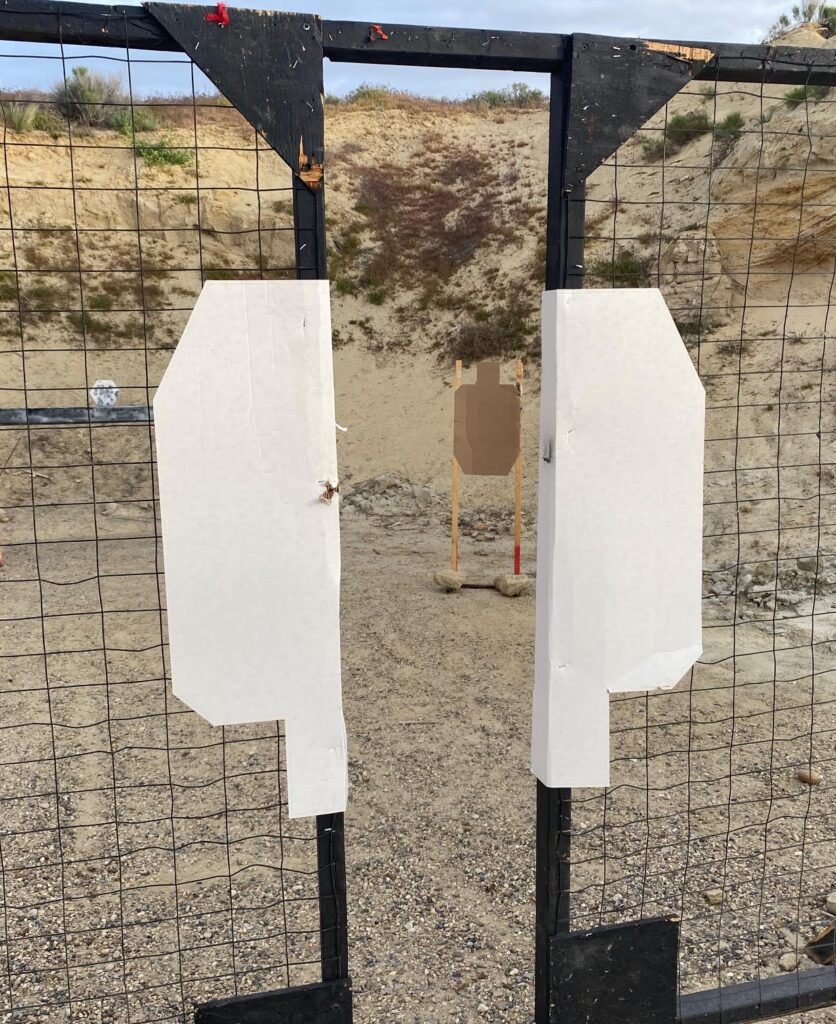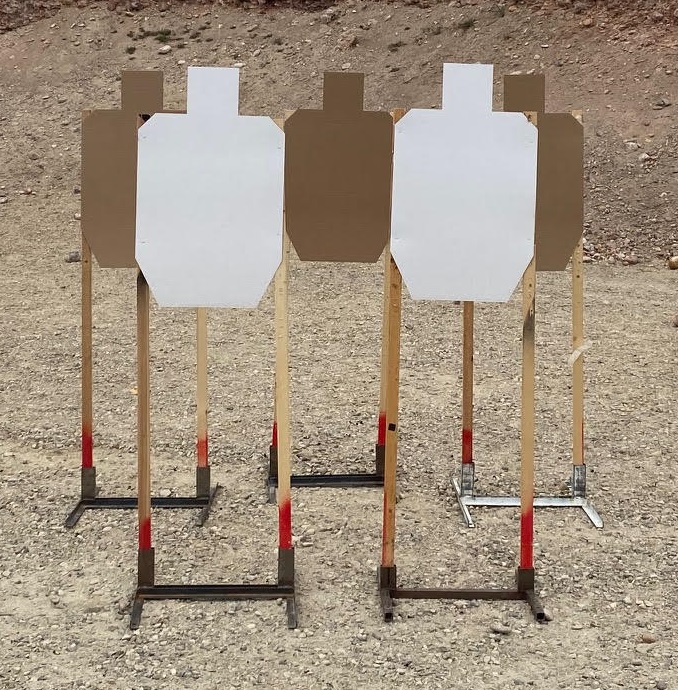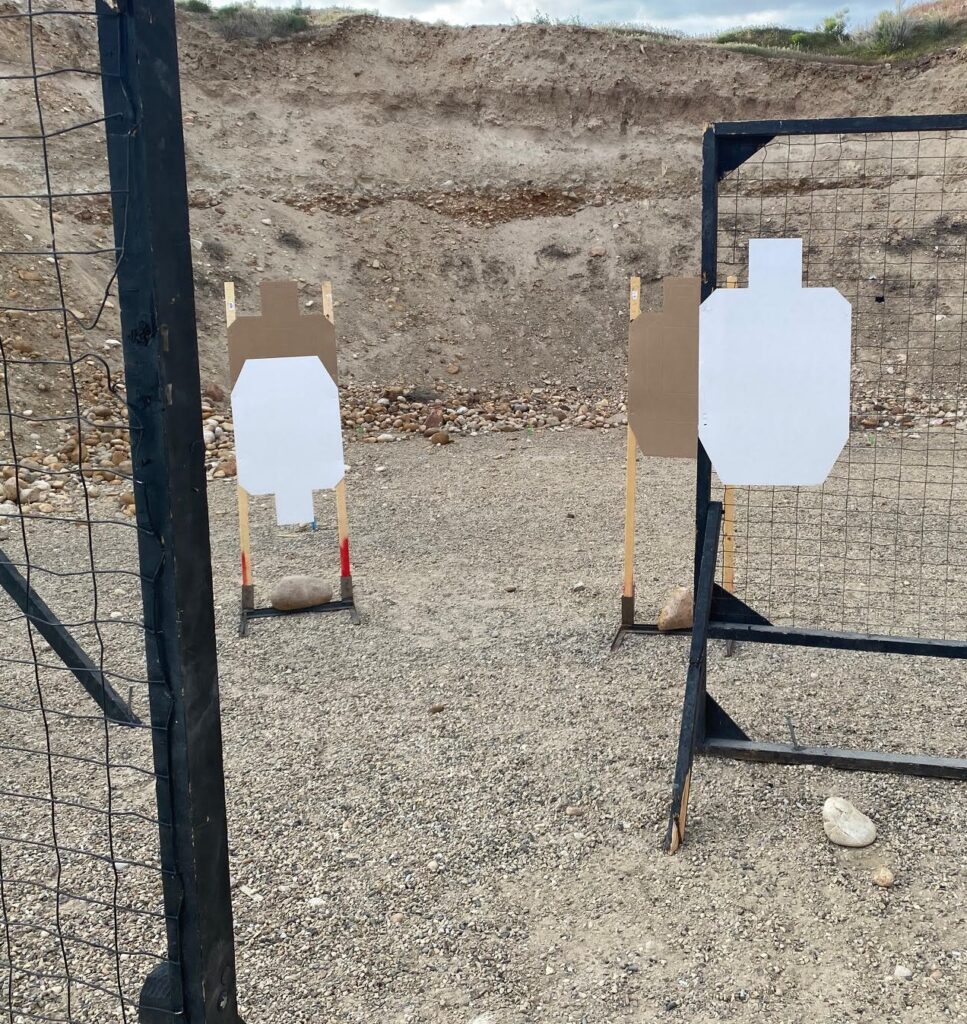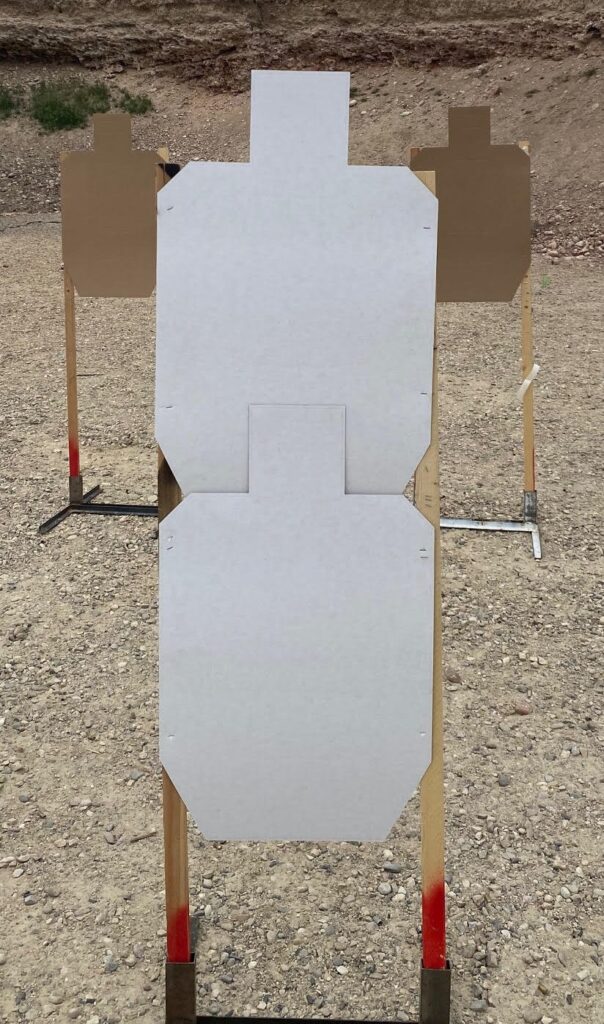One of the things we discuss in the Level I Range Officer and Level II Chief Range Officer seminars is how certain practices of using no-shoots can cause problems for ROs during the match. To be clear, we are not discouraging the use of no-shoots as a penalty target. In fact, we strongly endorse using no-shoots when used in conjunction with a scoring target where they are stapled together and in direct contact with one another (9.1.5.1.1). This is completely legit and the most problem-free use of a no-shoot.
The difficulty arises when someone staples a no-shoot to the wall to protect the frame from being shot up, or the stage designer wants to use free-standing no-shoots to partially obscure the view of a target, make shooters move a little deeper into a position, or as a vision barrier. Let’s discuss each of these scenarios:

1) Using no-shoots to protect the walls: I get it, I’ve spent many days at the range building or repairing walls and if I had my druthers, every time a competitor shoots up one of our walls they pay a $1 fine. To that end some MDs and/or stage designers will frame their ports with no-shoots in the fervent hope that people will aim a little more and not shoot up their walls. There are two problems with this scenario:
The first is rule 4.2.2.1 that says the face of all cardboard no-shoots must include a sufficiently distinguishable non-scoring border. As shown in the picture above where the no-shoots were wrapped around the edges of the wall port, we no longer have a non-scoring border where the no-shoot was folded around the wall frames. As a result, these cannot be used as actual no-shoots. At best, they are just there as a visual aid to help the RO spot any hits in the mesh wall.
The second issue in this scenario is rule 9.1.5 which states that the scoring area of targets and no-shoots are deemed to be impenetrable, and rule 9.1.5.1 says that if a bullet wholly strikes within the scoring area of a cardboard target and continues on to strike the scoring area of another target, the hit on the subsequent target will not count for score or penalty. As you can see in the picture there is a full diameter hit in the left no-shoot. The hit also impacted the wall frame beneath the no-shoot, so if the bullet continued on to strike the downrange cardboard target most likely that hit is going to look somewhat janky because wooden wall frames usually distort bullets enough to result in an odd-ball looking hit on a cardboard target. However, let’s say the bullet was a full diameter hit in the no-shoot where there wasn’t any wooden structure beneath it. In that case after going through the cardboard no-shoot any subsequent hit on a down range cardboard target is going to look like any other hit on that target. Determining which one of them first went through the cardboard no-shoot as is a miss per 9.1.5.1 will be difficult to determine, and most likely will result in a reshoot.

2) Free-standing no-shoots used to partially obscure targets: I saw this at a recent local match, and after setup we had a discussion about it. The stage designer’s intent behind setting up two free-standing no-shoots a couple feet in front of the three cardboard target array was to present the shooters with risk/reward options. Option 1, go for head shots to reduce the risk of hitting a no-shoot. Option 2, play it safe with C-zone hits. Option 3, move to the left and engage the left target from where you had a better angle past the no-shoot, and vice versa on the right target. It’s a neat idea and I understand what the stage designer was trying to achieve.
However once again, 9.1.5.1 comes into play. Any hits on the cardboard targets that first went through a no-shoot with a full diameter hit is going to be scored a miss. But which hit is the one that also went through the cardboard no-shoot? As mentioned earlier, cardboard does very little to distort a bullet or change the characteristic of the subsequent hit. So, if we did end up with a shoot-through from the no-shoot onto one of the cardboard scoring targets, there is going to be very little evidence that we can use to determine which one is the 9.1.5.1 miss. In which case, we’re most likely looking at a reshoot.

3) No-shoots on a wall to make us aim more: In this scenario the no-shoot was stapled to the edge of the wall with the intent of making the shooter slow down and aim a little more. This is a legal presentation per 4.2.2.1 because the factory non-scoring border is present, but we are going to have the same issues that we discussed in the above two scenario with regard to 9.1.5 and 9.1.5.1.

4) Use of No-shoots as a vision barrier: Sometimes clubs run out of walls or barrels, and no-shoots have been known to be used to construct vision barriers. If you’ve attended the Level I RO seminar you probably recognize the double no-shoot vision barrier in the RO Prez exercise diagram. Once again, this can cause scoring issues for ROs that we discuss in class. Usually after we bring up the implications of 9.1.5.1 we end up replacing the no-shoots with a double stack of barrels or a Bianchi barricade. Remember, per 9.1.6, unless specifically described as ‘soft cover’ in the WSB, all props, walls, barriers, vision screens and other obstacles are deemed to be impenetrable ‘hard cover.’ So, similar to 9.1.5.1, any full diameter hits in a wall or barrel stack that goes on to hit a scoring target will be considered a miss. But as discussed above, a wooden wall frame or plastic barrel will usually distort a bullet enough to be able to distinguish it when it hits a cardboard target. Shoot throughs that go through just a cardboard no-shoot, not so much.
Conclusion: The rulebook doesn’t prohibit MDs or stage designers from stapling a no-shoot to a wall or using one as free-standing. But as we described in this article, we’re going to have a difficult time, if not impossible, determining an accurate score after somebody drills a cardboard no-shoot with a full diameter hit and the bullet goes on to strike another target.
To further compound the problem, if the downrange target was a popper or plate in any of the three above scenarios, per 9.1.5.2 any full diameter hits through a target or no-shoot that continues on to strike down a popper or plate will be treated as a Range Equipment Failure and a reshoot.
To put it into another perspective, we spend a lot time during setup proofing stages to make sure we don’t have any shoot throughs from one target onto another. Well, the same principles apply to free-standing no-shoots for the same reasons, namely 9.1.5, the rule that says cardboard targets (which includes no-shoots) are impenetrable. Yet in real-life bullets will go through cardboard like a hot knife through butter, which then creates scoring issues for ROs. So, the moral of the story here is even though the rulebook does not prohibit the use of free-standing no-shoots, it is just not a good idea. You might not have any issues at a small 30 person match, but guaranteed you are going to have issues at a bigger match with more people.